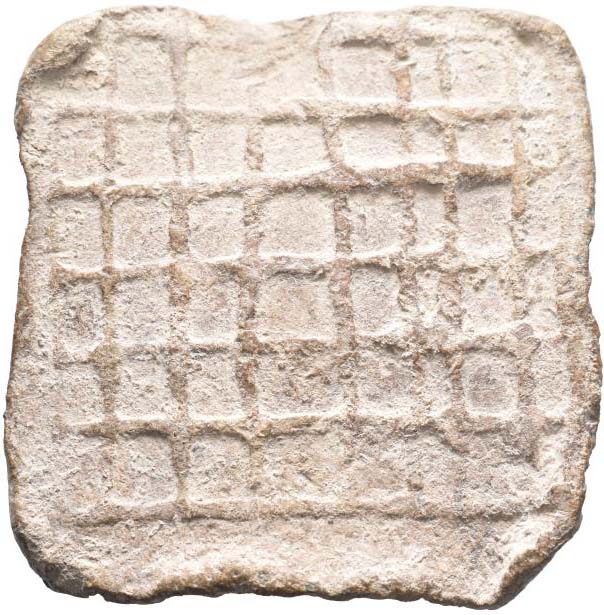
-
Copyright credit: Auction Leu 2024

-
Copyright credit: Auction Leu 2024

-
Copyright credit: Auction Leu 2024

-
Copyright credit: Private Collection

-
Copyright credit: Private Collection

-
Copyright credit: Private Collection

ARCHAEOLOGICAL DESCRIPTION OF THE WEIGHT
Authority
Unidentified
Mint
South Syrian or Phoenician mint
Denomination
1/4 Mina
Material
Lead
Manufacture
Cast
Shape
Square
Length
16.51 cm
(6.5 inch)
Width
6.50 cm
Height
- cm
Metrology
| Mass (g) | Mass (grain) | Date of measurement | Reference | fragmented | cleaned | reference weight |
|---|---|---|---|---|---|---|
| 188.19 | - | - | Auction Leu 2024 | No | No | Yes |
Iconography
| Symbol | Technique | Direction | Position | Number | Synecdoche |
|---|---|---|---|---|---|
| Ear of wheat | Relief | ||||
| Lattice pattern | Relief |
Wear
Corrosion
Handle
No
Suspension hole
No
Recarved mould
Yes
Recarved weight
No
Intentionally destroyed
No
Archaeological description
Auction Leu 2024: LEVANTINE REGION. Uncertain, 1st century BC. Weight of 1 Tetarton (Lead, 62 x 65 mm, 188.19 g), year 27 of an unknown era. ETOYΣ ZK / MK / AΓO-PANO/MON-TOΣ / ...OY / TETAPTON in six lines; in the center, grain ear. Rev. Latticework design. Pondera -. Unpublished. Minor scuffs on the obverse, otherwise, very fine.
Autopsy
No
INSCRIPTION
| Language | Technique | Legend type |
|---|---|---|
| Greek | Relief | Authority, Date, Denomination |
Fac simile
ΕΤΟΥΣΖΙ
ΙΙΚ
ΑΓΟ ΡΑΝΟ
ΜΟΥ ΝΤΟΣ
. . . . . . ΟΥ
ΤΕΤΑΡΤΟΝ
Edition
Ἔτους ζι´ (or ζκ´?) | Μ< (?) | ἀγο–ρανο|μοῦ–τος | .Ω–...ΟΥ | τέταρτον.
L. 1–2: Ἔτους ζ|μρ´ (?)
L. 1–2: Ἔτους ζ|μρ´ (?)
Monogram
ARCHAEOLOGICAL CONTEXT
Findspot (region)
Findspot (site)
context
CIRCUMSTANCES OF ACQUISITION
Region
City
Date of first acquisition
Sept. 8, 2024
circumstances
Antiquities trade.
DATING OF THE WEIGHT
Curatorial Section
GREEK
Time frame
FROM
-250
TO
-1
Comments on Chronology
Ἔτους ζ|μρ´ (S.E. 147 = 166/5 BCE)? or rather Ἔτους ζι´ (or ζκ´?) = Year 17 or 27 of an unidentified civic era?
COLLECTION HISTORY
Collection
| Name | Date of acquisition | Inventory number |
|---|---|---|
| Antiquities Trade | Sept. 8, 2024 | None |
Bibliography
| Reference | Page/Column | Reference (number) | Plate / Figure | Comment |
|---|---|---|---|---|
| Auction Leu 2024d | None | 1632 | None | None |
VARIA
Additional comment
The ear of wheat is attested in Scythopolis, Berytos or Laodicea. Compare e.g. with https://pondera.uclouvain.be/artifact/14860/
Auction Leu 2024: This weight is dated to the 27th year of an unknown, likely local era. It probably originates from the 1st century BC, when many cities in the Levant abandoned the Seleukid era and established their own eras. Weights with grain ears have so far been known from Laodikeia, Berytos, and Skythopolis. Whether our specimen also comes from one of these cities or another polis remains uncertain due to the absence of an ethnic.
Auction Leu 2024: This weight is dated to the 27th year of an unknown, likely local era. It probably originates from the 1st century BC, when many cities in the Levant abandoned the Seleukid era and established their own eras. Weights with grain ears have so far been known from Laodikeia, Berytos, and Skythopolis. Whether our specimen also comes from one of these cities or another polis remains uncertain due to the absence of an ethnic.
Permalink
External link